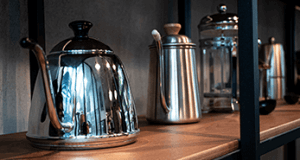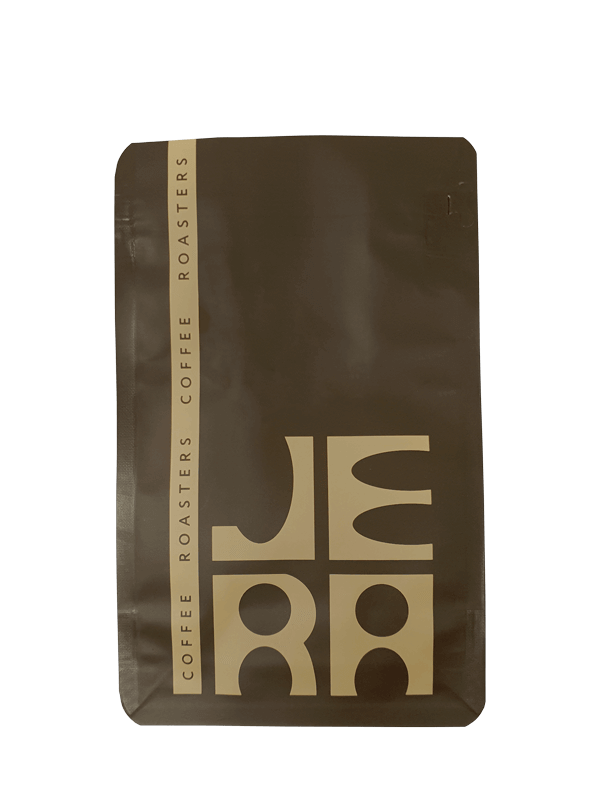קפה קלוי קולומביה | Huila, Finca Las Flores
קפה קלומביאני מזן טבי בעיבוד שטוף טרמל שוק
מאוד נקי, קליל ועסיסי. מתיקות גבוהה, מרירות נמוכה וחמיצות נעימה של פירות יער. טעמים של פטל ורימון. מצוין להכנת כל סוגי קפה פילטר!
₪75.00 – ₪300.00
ברכישת כל סוגי קפה קלוי בסכום:
בין 600 ש"ח ל-1000 ש"ח עם קוד קופון "15%" תקבלו 15% הנחה
Colombia Las Flores
חוות לאס פלורס ממוקמת באזור וילה שבקולומביה, בגובה של 1,730 מטר מעל פני הים. שטח החווה משתרע על פני 14 הקטארים, ובה מתבצעים שני מחזורי קטיף בשנה — הקטיף העיקרי מתקיים בין פברואר למרץ, והקטיף המשני מתקיים בין ספטמבר לאוקטובר.
החווה נוסדה בשנת 1990 על ידי אם המשפחה ורגארה, שהחלה בנטיעת 18,000 עצי קפה. מדי שנה הרחיבה המשפחה את הנטיעות, עד שהגיעה ל-90,000 עצים.
בשנת 2006 השתתפה לאס פלורס לראשונה בתחרות Cup of Excellence, וזה היה הרגע שבו החלה דרכה בעולם הקפה הספיישלטי והייחודי. בשנים הבאות השקיעה המשפחה זמן ומאמץ בניסויים ובמחקר, צברה ידע וניסיון בזיהוי פרופילי הטעם של הקפה שלהם, ושיפרה את הגידול החקלאי ואת איכות המשקה.
כל פולי הקפה בלאס פלורס נקטפים ידנית בקפידה ומיובשים בצורה טבעית, כדי לשמור על עקביות גבוהה באיכות. החווה משתמשת בשיטות תסיסה מגוונות — כולל חמצון ואחריו תסיסה אנאירובית בשקיות אטומות — על מנת לפתח פרופילי טעם ייחודיים ומורכבים.
מאז 2017 עברה פינקה לאס פלורס מהתמקדות בייצור קפה קונבנציונלי ליצירה של לוטים באיכות גבוהה ומובחנת. המעבר הזה כלל הכנסת זנים חדשים כגון פינק בורבון, טאבי וסידרה, וכן פיתוח ויישום של טכניקות חדשניות לתסיסה ולייבוש.
למרות שגידול הזנים האקזוטיים האלה מאתגר יותר, והעיבוד דורש יותר עבודה והוא גם מסוכן יותר, התוצאה היא קפה יוצא דופן באיכותו — שלרוב נמכר במחירים גבוהים יותר בשוק הקפה הספיישלטי.
קפה טבי (Tabi)
טבי הוא זן קפה שפותח והושק בשנת 2002 על ידי הפדרציה הלאומית של מגדלי הקפה בקולומביה, כחלק ממאמצי המדינה להתמודד עם מחלת חלודת העלים. הזן נוצר מהכלאה בין בורבון, טיפיקה וטימור — מתוך מטרה לשלב עמידות למחלות עם פרופיל טעמים איכותי, הדומה להוריו.
השם "טבי" מגיע משפת הגואמביאנו, שפתו של שבט ילידי בקולומביה, ומשמעותו "טוב". ואכן, זן זה משלב את איכויות הטעם המעודנות של בורבון וטיפיקה עם עמידות גבוהה יותר לחלודת העלים.
עיבוד בשטיפה עם שוק תרמי
לאחר קטיפת הדובדבנים, הם עברו ארבעה שלבים עיקריים בתהליך העיבוד. בשלב הראשון הם הושרו במים לצורך מיון וסילוק פגמים. לאחר מכן נשטפו בהיפוכלוריט כדי להסיר זיהומים, והושארו להתחמצן על יריעות במשך 48 שעות.
בהמשך, הוסרה מהם הקליפה והם הושארו לתסוס בריר הטבעי שלהם במשך 36 שעות. לאחר התסיסה, עברו הדובדבנים תהליך של שוק תרמי, שבמהלכו נוספו מים חמים בטמפרטורה של 50°C למכלי התסיסה, כך שהקפה נשאר שקוע לחלוטין במים למשך 36 שעות נוספות.
השלב האחרון היה הייבוש, שנמשך כ-10 ימים, בהתאם לתנאי מזג האוויר.
קפה מקולומביה
קולומביה היא מדינה הררית, עם גבהים שמגיעים עד 2,200 מטר מעל פני הים. הקפה גדל במדרונות תלולים, ולכן יש לקטוף אותו כולו ביד. המדינה נמצאת ישירות על קו המשווה, ובשילוב עם טווח הגבהים הרחב שבה, ניתן לקצור קפה כמעט כל השנה. רוב הקפה הקולומביאני מגודל בחוות קטנות שבבעלות חקלאים עצמאיים — גודל ממוצע של חווה הוא רק 3 דונם. רבות מהחוות ממוקמות ביערות הרריים, שם הקפה גדל בצל עצים, והגישה אליהן יכולה להיות קשה מאוד. לעיתים קרובות אי אפשר להגיע אליהן ברכב, ולכן חקלאים רבים משתמשים בסוסים או חמורים — שיכולים לעבור במקומות שרכב אינו מסוגל.
האקלים הלח והטמפרטורות הנמוכות בגבהים הגבוהים גורמים לכך שעיבוד רטוב (washed) הוא השיטה הנפוצה ביותר לעיבוד קפה בקולומביה.
קולומביה היא יצרנית הקפה השלישית בגודלה בעולם. חוות הקפה במדינה ממוקמות באזורים הרריים, בטווח גבהים של בין 1,000 ל-2,300 מטר מעל פני הים. בזכות טווח הגבהים הרחב הזה, קולומביה מציעה מגוון רחב של פרופילים לקפה — מקפה קליל ופרחוני ועד קפה עשיר ושוקולד
מיקרולוט
מיקרולוט הוא אצווה של קפה מעונה מסוימת, שקיבלה ציון גבוה בקאפינג ואפשר לעקוב אחרי מקורו. אנחנו יודעים באיזה אזור הוא גדל, איזה חקלאי גידל אותו, איך הוא נקטף ואיך הוא עובד. המידע הזה כשלעצמו לא משפיע ישירות על הטעם. עם זאת, כאשר חקלאי מוכר קפה ישירות, זה בדרך כלל אומר שהקפה גודל, נקטף ועובד בצורה הרבה יותר מוקפדת — מה שבדרך כלל מביא לטעם טוב יותר. גידול של קפה יוצא דופן דורש תשומת לב רבה בכל שלב: מתנאי הגידול ובחירה של דובדבנים בשלים בלבד, ועד בקרה קפדנית על תהליך העיבוד. כדי לגדל קפה כזה, חקלאים משקיעים הרבה מאמץ וכסף. באותו הזמן, הם לוקחים סיכונים משמעותיים — אפילו תקופה קצרה של תנאים לא מתאימים יכולה להרוס את כל מאמציהם. הקפה אולי ייצא טוב, אבל כבר לא יהיה ייחודי, והחקלאי עלול להפסיד כלכלית. מיקרולוטים בדרך כלל יקרים יותר מקפה רגיל משתי סיבות: ראשית, לקפה כזה ניתנת תשומת לב רבה בכל שלב של הייצור. החקלאים חייבים לטפל בגידול בקפידה, לקטוף אותו בדיוק ולעבד אותו בנפרד מהשאר. זה מעלה את עלויות הייצור — ולכן גם את המחיר הסופי. שנית, כתוצאה מהשקעה בפרטים הקטנים, הטעם של קפה כזה יוצא לרוב בהיר ונקי יותר באופן משמעותי. בהרבה חוות מוכרות, הקונים מזמינים מיקרולוטים שנים מראש. בשל הביקוש הגבוה, החקלאים מעלים את המחירים.
פייר טרייד (Fair Trade)
מטרת הסמכה זו היא לתמוך בתנאי עבודה ושכר הוגנים בחוות במדינות מתפתחות. באופן מסוים, היא מקדמת סחר הוגן, ולא מתייחסת רק לקפה אלא גם למוצרים נוספים. ההסמכה פופולרית במיוחד בקרב צרכנים במדינות מפותחות שבהן קיימת מודעות גבוהה יותר לצריכה מוסרית – בעיקר בארצות הברית ובצפון אירופה.
הסמכת Fair Trade מבטיחה שלא נעשה שימוש בעבודת ילדים בחוות, שעובדים מקבלים שכר הוגן, ושמתקיימים תקני בריאות ובטיחות בעבודה. הארגון מבצע בדיקות שוטפות בחוות המאושרות כדי לוודא שהן עומדות בדרישות.
Colombia Las Flores
Las Flores Farm is situated in Colombia’s Huila region at an elevation of 1,730 meters above sea level. Spanning 14 hectares, the farm produces two coffee harvests per year—the main crop takes place from February to March, while a smaller mid-crop occurs between September and October. The farm was founded in 1990 by the Vergara family matriarch, who began by planting 18,000 coffee trees. Each year, the family expanded the plantation, eventually reaching 90,000 trees. In 2006, Las Flores entered the Cup of Excellence competition. This marked the beginning of their journey into the world of specialty and differentiated coffee. Over the following years, they dedicated themselves to research and experimentation, gaining valuable experience in identifying their coffees’ unique flavor profiles and improving both their agricultural practices and cup quality. All the coffee at Las Flores is carefully handpicked and naturally dried to maintain a high level of consistency. The farm uses a variety of fermentation methods—including oxidation followed by anaerobic fermentation in sealed bags—to develop distinct and complex flavor profiles. Since 2017, Finca Las Flores has shifted its focus from producing conventional coffees to crafting high-quality, differentiated lots. This transformation included introducing new varieties like Pink Bourbon, Tabi, and Sidra, as well as experimenting with innovative fermentation and drying techniques. Although these exotic varieties are more challenging to cultivate and the processing methods more labor-intensive and risky, the resulting coffees stand out for their exceptional qualities—and they frequently command higher prices in the specialty coffee market.
Tabi Coffee
Tabi is a coffee cultivar introduced in 2002 by the Colombian National Federation of Coffee Growers as part of the country's strategy to fight leaf rust. It was developed by crossing Bourbon, Typica, and Timor varieties to create a plant that combines disease resistance with the desirable flavor characteristics of its parent cultivars.
The name “Tabi” comes from the Guambiano language (spoken by an Indigenous community in Colombia) and means “good.” True to its name, Tabi offers the elegant cup qualities of Bourbon and Typica, while also providing greater resistance to leaf rust.
Washed thermal shock process
Once the cherries were harvested, they went through four main processing stages. The first involved floating them in water to sort and remove defective ones. They were then washed with hypochlorite to eliminate impurities and left to oxidize on tarps for 48 hours. Next, the cherries were depulped and allowed to ferment in their own mucilage for 36 hours. Following fermentation, they underwent a type of thermal shock, during which hot water at 50°C was added to the fermentation tanks, keeping the coffee fully submerged for another 36 hours. The final stage was drying, which took place over approximately 10 days, depending on weather conditions.
Coffee from Columbia
Colombia is a mountainous country, with elevations reaching up to 2,200 meters. Coffee grows on steep hillsides, so it must be harvested entirely by hand. The country lies directly on the equator, and combined with its broad altitude range, this allows for nearly year-round harvesting. Most Colombian coffee is grown on small farms owned by independent farmers — the average farm size is only 3 hectares. Many of them are located in mountain forests, where coffee grows in the shade of trees, and accessing these farms can be extremely difficult. Often, it's impossible to reach them by car, so horses or donkeys are commonly used by farmers — they can pass where vehicles cannot.
The country’s humid climate and low temperatures at high altitudes make washed processing the most common method for Colombian coffee.
Colombia is the third largest coffee producer in the world.
Coffee farms in the country are located in mountainous regions, ranging from 1,000 to 2,300 meters above sea level. Due to this wide altitude range, Colombia offers a great diversity of coffee profiles—from light and floral to rich and chocolatey.
Microlot
A microlot is a batch of coffee from a specific harvest season that has received a high cupping score and has traceable origins. We know which region it was grown in, which farmer cultivated it, how it was harvested, and how it was processed. This information alone doesn’t directly affect the taste. However, if a farmer sells coffee directly, it usually means the coffee is grown, harvested, and processed with much more care — which typically results in better flavor. Growing exceptional coffee requires close attention at every stage: from the growing conditions and the selection of only ripe cherries to careful control during processing. To grow such coffee, farmers invest a great deal of effort and money. At the same time, they take significant risks — even a brief period of unfavorable conditions can undo all their efforts. The coffee may still turn out good, but no longer unique, and the farmer may end up with financial losses. Microlots are usually more expensive than regular coffee for two reasons: First, this type of coffee is given more attention at every stage of production. Farmers must carefully tend to the crop, harvest it with precision, and process it separately from the rest of the coffee. This increases production costs — and therefore the final price. Second, as a result of this attention to detail, the flavor of such coffee is often significantly brighter and cleaner. On many well-known farms, buyers reserve microlots years in advance. Due to high demand, farmers raise prices.
Fair Trade
The goal of this certification is to support fair working conditions and wages on farms in developing countries. In a way, it advocates for fair trade and applies not only to coffee but also to other products. It is especially popular among consumers in developed countries with more conscious consumption habits — mainly in the U.S. and Northern Europe.
Fair Trade certification means that no child labor is used on the plantation, and workers receive fair wages while health and safety standards are maintained. The organization regularly inspects the conditions on certified farms to ensure compliance.










